A) a binding minimum wage; union wages
B) a binding minimum wage; union wages.
C) a nonbinding minimum wage; union wages
D) a nonbinding minimum wage; union wages.
E) economic downturns; efficiency wages
F) economic downturns; efficiency wages.
G) beneficial unemployment insurance benefits; efficiency wages.
H) beneficial unemployment insurance benefits; efficiency wages
J) A) and C)
Correct Answer

verified
Correct Answer
verified
Multiple Choice
Suppose a labor market is described by the demand equation, Qd = 60 - 2w, and the supply equation, Qs = -10 + w, where Qd is the quantity demanded of labor, Qs is the quantity supplied of labor, and w is the wage (in dollars) . If the government institutes a minimum wage of $25, how many workers will be willing to work in this market?
A) 5,000,000
B) 20,000,000
C) 10,000,000
D) 15,000,000
F) B) and D)
Correct Answer

verified
Correct Answer
verified
Multiple Choice
When Tayla was laid off at the beginning of 2020, she looked for a job for three months but could not find anything suitable. She then volunteered in a soup kitchen, giving up her job search. Tayla is considered to be:
A) unemployed
B) unemployed.
C) underemployed.
D) underemployed
E) marginally attached.
F) marginally attached
G) a part-time worker
H) a part-time worker.
J) A) and E)
Correct Answer

verified
Correct Answer
verified
Multiple Choice
Refer to the following table that shows monthly data for Japan. What was the total number of people (in millions) in the labor force in January 2014?
A) 65.4 million
B) 65.7 million
C) 68.1 million
D) 66.3 million
F) A) and C)
Correct Answer

verified
Correct Answer
verified
Multiple Choice
Which of the following is an economic cost of unemployment? (i) Unemployed people often accept lower wages when they eventually find work. (ii) Hysteresis occurs. (iii) The unemployment rate falls. (iv) Children whose parents are unemployed have lower academic outcomes.
A) (i) and (ii)
B) (ii) and (iii)
C) (iv) only
D) (iii) and (iv)
F) A) and C)
Correct Answer

verified
Correct Answer
verified
Multiple Choice
(Table: Population Data for Estill County) If marginally attached workers are included, the number of persons in the labor force in Estill County is: 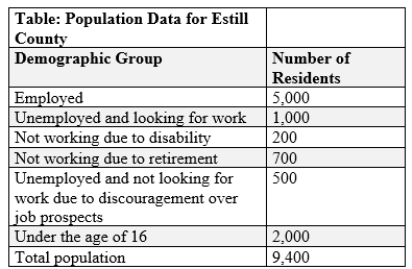
A) 7,400.
B) 7,400
C) 6,500.
D) 6,500
E) 6,000
F) 6,000.
G) 5,500.
H) 5,500
J) A) and E)
Correct Answer

verified
Correct Answer
verified
Multiple Choice
(Table: Population Data for Estill County) How many people are in the labor force? 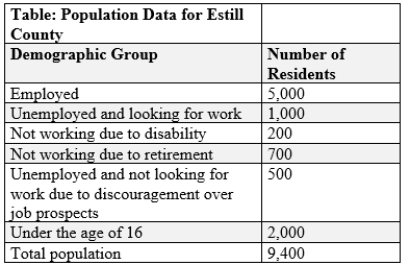
A) 6,000
B) 6,000.
C) 9,400.
D) 9,400
E) 7,400
F) 7,400.
G) 6,500.
H) 6,500
J) A) and D)
Correct Answer

verified
Correct Answer
verified
Multiple Choice
In March 2010, California reported a civilian labor force of 18,304,098. The number of unemployed people was 2,242,732. What was the unemployment rate?
A) 19.6%
B) 87.7%
C) 10.2%
D) 12.3%
F) All of the above
Correct Answer

verified
Correct Answer
verified
Short Answer
Consider the labor market shown here. Suppose the government enacts a minimum wage of $11. Answer the following questions:
(a) How many workers are employed after implementation of the minimum wage?
(b) How many workers are available to work after the minimum wage is implemented?
(c) After implementation of the minimum wage, does the number of employed workers increase or decrease? By how many workers?
(d) After implementation of the minimum wage, does the number of workers who are willing to work increase or decrease? By how many workers?
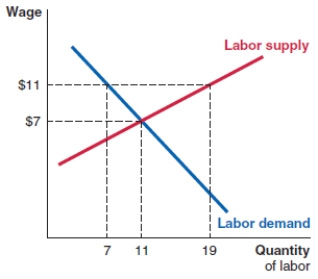
Correct Answer

verified
Correct Answer
verified
Multiple Choice
The equilibrium unemployment rate is the:
A) rate of unemployment that exists when demand equals supply in a given market.
B) frictional unemployment rate plus the cyclical unemployment rate.
C) short-run unemployment rate when the economy is in a recession.
D) rate of unemployment that exists even when cyclical unemployment has gone to zero.
F) All of the above
Correct Answer

verified
Correct Answer
verified
Multiple Choice
In order to be considered unemployed, the person must be: (i) over the age of 16. (ii) actively searching for work. (iii) available to work. (iv) skilled.
A) (i) , (ii) , (iii) , and (iv)
B) (ii) and (iv)
C) (i) , (ii) , and (iii)
D) (iii) and (iv)
F) B) and C)
Correct Answer

verified
Correct Answer
verified
Multiple Choice
Which of the following can help you protect yourself from the harmful effects of unemployment? (i) Build up some savings. (ii) Watch for new opportunities even while you are employed. (iii) Maintain a good network of friends and colleagues who might be able to refer you to new jobs. (iv) Send out as many job applications as possible.
A) (i) , (ii,) and (iii)
B) (i) and (iv)
C) (i) , (ii) , (iii,) and (iv)
D) (iv) only
F) A) and C)
Correct Answer

verified
Correct Answer
verified
Multiple Choice
Suppose that there are 70 million people in the labor force, of whom 60 million are employed. The unemployment rate is:
A) 7%.
B) 7%
C) 10%.
D) 10%
E) 14.29%.
F) 14.29%
G) 4.2%
H) 4.2%.
J) C) and E)
Correct Answer

verified
Correct Answer
verified
Multiple Choice
Consider the graph of the labor market shown here. At the wage rate of $14, the number of unemployed people in this market is:
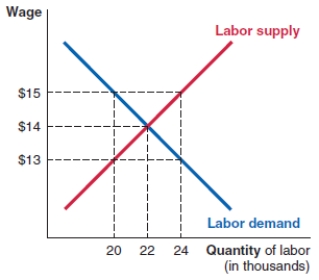
A) 4,000.
B) 2,000.
C) 22,000.
D) zero.
F) All of the above
Correct Answer

verified
Correct Answer
verified
Multiple Choice
Public policy can assist in improving the matching of jobs to workers by:
A) controlling the number of jobs that are offered by businesses.
B) lowering minimum wages.
C) running job search centers to help businesses identify unemployed people with the right skills.
D) providing unemployment benefits for unemployed workers.
F) A) and C)
Correct Answer

verified
Correct Answer
verified
Multiple Choice
Employment and Unemployment is the:
A) percent of the labor force that is unemployed.
B) percent of the labor force that is unemployed
C) number of people unemployed.
D) number of people unemployed
E) the labor force minus the number of people unemployed
F) the labor force minus the number of people unemployed.
G) average length of time someone is unemployed.
H) average length of time someone is unemployed
J) A) and B)
Correct Answer

verified
Correct Answer
verified
Multiple Choice
You have four friends. Which of your friends can be described as "structurally unemployed"?
A) Dolly, a recent graduate who is looking for the job that best suits her qualifications
B) Kirstie, who was fired for being inefficient at her job
C) Kevin, who does not like the company he works for
D) Marty, who cannot find a job, though he is willing to accept less than the existing wage
F) A) and D)
Correct Answer

verified
Correct Answer
verified
Multiple Choice
(Table: Unemployment and Employment Data) If marginally attached workers are included in the labor force and in the unemployment rate, the unemployment rate in this economy is _____. 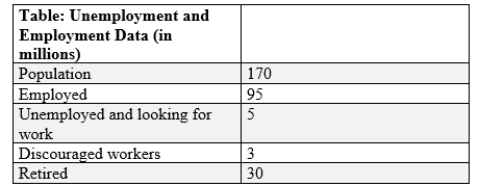
A) 8.4%.
B) 8.4%
C) 7.8%.
D) 7.8%
E) 5%.
F) 5%
G) 3%.
H) 3%
J) A) and F)
Correct Answer

verified
Correct Answer
verified
Multiple Choice
The table shows statistics for three Canadian cities at several different points in time. What was the number of unemployed people (in thousands) in Vancouver in January 2009?
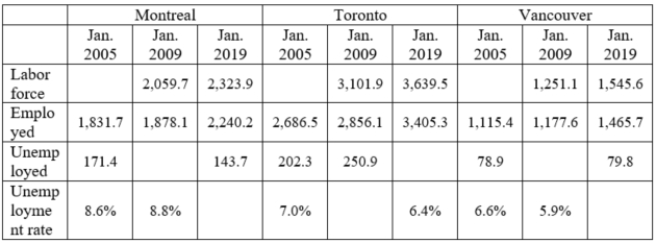
A) 73.5
B) 1,177.6
C) 1,251.1
D) 79.8
F) C) and D)
Correct Answer

verified
Correct Answer
verified
Multiple Choice
(Figure: The Labor Market) Use Figure: The Labor Market. What is the size of the labor force at an efficiency wage of $16?

A) 80,000
B) 80,000.
C) 100,000.
D) 100,000
E) 110,000
F) 110,000.
G) 200,000.
H) 200,000
J) A) and H)
Correct Answer

verified
Correct Answer
verified
Showing 21 - 40 of 167
Related Exams